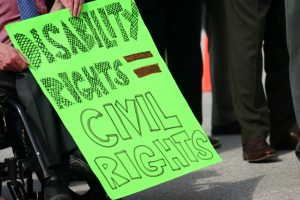32 Disability rights advocacy goes digital
Filippo Trevisan, American University
In 1980, scholar and activist Vic Finkelstein pictured a future in which “impaired persons will […] no longer be oppressed by disabling social conventions and disabling environments but will be absorbed in the mainstream of social interactions.” In his vision, technology was to be an important enabler of social change and play a fundamental role in the “liberation” of disabled people. Today, we live in a world where connectivity is ubiquitous and new media technologies foster “always on” lifestyles. Yet, Finkelstein’s hypothesis remains largely untested and our understanding of the relationship between disability and the Internet is incomplete.
“Digital disability” studies, as Gerard Goggin and Christopher Newell described the study of the relationship between disability and digital media just over a decade ago, have grown substantially in recent years. Yet, virtually all of this work has framed the discussion in terms of access and accessibility. Indeed, these are crucial issues that ought to be top priorities for policy-makers, technology developers, and disability campaigners. At the same time, however, I also believe that limiting ourselves to this perspective will lead us to overlook an essential part of the picture. A different aspect that certainly deserves to be explored is that of online disability rights advocacy.

As a passionate observer of the potential of new media technologies for empowering groups that traditionally are excluded from the civic arena, I have been watching with great interest as UK disability rights groups “tuned” into social media in ever increasing numbers from late 2010 onwards. This was a major shift in their approach to technology as, as recently as 2009, disability organizations appeared somewhat distrustful towards ICTs and particularly reluctant to engage with social media.
All this changed suddenly in response to the then Conservative-Liberal Democrat UK government’s proposals for a radical overhaul of disability welfare in 2010, which challenged some of the main principles behind disability welfare entitlement and allocations. Very rapidly, a range of different disability groups decided that it was time to use digital media for mobilizing, organizing, and challenging legacy media narratives of disability welfare. Not only established charity organizations experimented with innovative tactics in digital campaigning, but new collaborations were forged too, sometimes where ancient rifts had existed, and wholly new groups of disabled activists were formed online. Given their internal structure, type of leadership, and relationship with the Internet, I proposed in previous work that these groups could be seen as falling into three different categories, including:
- Formal organizations: pre-existing disability organizations that use the Internet to boost their campaigns (including both non-profit and membership groups);
- “Digitized” activists: experienced disabled activists who met in person at a protest event and thereafter decided to set up a Web presence as a way to sustain their efforts in the longer term; and
- Digital action networks: activist networks founded by disabled bloggers and operating exclusively online.
Among the most high-profile representatives of this new digital wave in disability rights advocacy were groups such as Disabled People Against Cuts (DPAC), The Broken of Britain, The Campaign for a Fair Society, We Are Spartacus, and issue-focused coalitions such as The Hardest Hit. For many of these groups campaigning online against the UK welfare reform became a journey of discovery. Since 2010, some of these groups were disbanded, some disappeared for some time and then re-appeared with a different name, while others continue to this day under the same banner, most notably DPAC. My impression is that disability advocacy in Britain is in a state of flux and digital media interact with other factors to constantly re-shape individual groups, their membership, and tactics. However, in broader terms, I believe that the typology I proposed back in 2011 still stands.
One thing that has really struck me as about these groups is the impressive array of online platforms on which they have been able to operate, often displaying terrific technological know-how. From Facebook to Twitter, and from websites to blogs, these groups have been capable of coordinated efforts that combine multiple digital outlets in a complementary fashion. Moreover, interviews with disabled bloggers from digital action networks revealed that familiarity with ICTs, combined with direct experience of impairment, can generate innovative uses of online platforms and “DIY” solutions to some of the difficulties determined by poor technological design.
There is vibe and excitement in the UK around digital disability rights campaigns, not least because “they make disabled people feel less useless,” as a disabled activist once told me. Disability rights advocacy is alive and energized both online and offline, with the addition of new faces, who often join through digital channels and bring a wealth of experience with digital storytelling. In particular, personal stories have come to the fore in many of these groups’ efforts to stop the welfare reform in recent years. This has been the case, for example, with DPAC’s “ILF Stories” campaign in 2013, which used personal accounts to provide an overview of the beneficial effect that the Independent Living Fund has on disabled people’s lives and illustrate what its closure would mean for impaired and chronically ill people. While the use of tactics such as this one would have been unthinkable just a few years ago, given the controversial role of personal stories in disability advocacy, the groups experimenting with them have learnt from each other, as well as drawn inspiration from international examples. Looking at the ILF stories, similar campaigns organized in previous years by U.S. disability organizations to protect Medicaid provisions for disabled Americans come to mind.
Does this mean that we are witnessing a globalization of disability advocacy tactics fostered by technological change? Not necessarily. Online advocacy strategies, what work and what doesn’t, but also what is acceptable and what isn’t, are born out of a mix of factors in which technology is only one element. While cultural, historical, and political differences also play a role, it is sometimes the policy context, and more specifically the policy agenda of the day, that can precipitate certain uses of social media by advocacy networks. This was the case for the groups involved in opposing the UK welfare reform. It is when people feel threatened that they are most likely to share their anger and frustration through digital communications. Thus, events will continue to shape the future of digital disability advocacy in ways that, at least in part, are excitingly unpredictable. Future work in this area ought to include the perspective of disabled Internet users, now a majority among disabled people in both the UK and the U.S.
Filippo Trevisan is Assistant Professor in American University’s School of Communication. His research explores the impact of new media technologies on advocacy, activism, and political communication. His work has focused in particular on the use of online media in the British and American disability rights movements. He also has a strong interest in comparative media analysis and has studied how voters use Google to find information about elections in the UK, the U.S., Italy, and Egypt. His research has been published in journals including Information, Communication & Society, First Monday, and Disability & Society. He can be found on Twitter as @filippotrevisan


